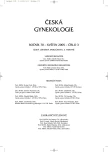-
Medical journals
- Career
Premature Separation of the Placenta – Etiology and Risk Factors
Authors: M. Procházka; Milan Kudela; M. Lubušký; M. Větr; P. Hrachovec; P. Zielina
Authors‘ workplace: Porodnicko-gynekologická klinika LF UP, Olomouc, přednosta prof. MUDr. M. Kudela, CSc.
Published in: Ceska Gynekol 2005; 70(3): 175-179
Category: Original Article
Overview
Objective:
Placental abruption complicates approximately 1% of all pregnancies and remains a significant cause of both maternal and fetal morbidity and mortality. Several risk factors are associated with this complications, but a clear causal relation is diffucult to establish.The aim of the study:
The aim of the study was to determine and identify risk factors for placental abruption.Design:
Retrospective cohort study.Setting:
Dept. of Obstetrics and Gynaecology, Medical Faculty of Palacký University, Olomouc.Subject and Method:
Retrospectively gathered cohort of 180 women was compared to 198 healthy women. We have focused on anthropometric, sociodemographic, behavioral, obstetric and fetal parameters. Statistical evaluation was done by Statsoft, Inc. (2001) Statistika CZ (Software system data analysis), version 6.Results:
The incidence of the placental abruption was 0.89%. We have confirmed the following risk factors as statistically significant (p values are given): Low-degree education (0.00002), prepregnancy weight of the mother (0.00), weight gain in pregnancy (0.00), higher parity (0.0272), smoking (0.03847), preeclampsia (0.00889), chorioamnionitis (0.00), premature rupture of membranes (0.00), recurrent spontaneous abortions (0.00), positive family history of deep venous thrombosis (0.0007) and intrauterine growth retardation (0.0386).Conclusion:
Placental abruption has a large number of potential risk factors. The true biological cause and its etiopathogenic role is still to be elucidated.Key words:
placental abruption, risk factors, etiology
Labels
Paediatric gynaecology Gynaecology and obstetrics Reproduction medicine
Article was published inCzech Gynaecology

2005 Issue 3-
All articles in this issue
- Premature Separation of the Placenta – Etiology and Risk Factors
- Nalbuphine in Obstetrical Analgesia
- Changes of Coagulation Parameters during Stimulation in the IVF Programme and in Ovarian Hyperstimulation Syndrome
- Influence of Exogenous Supplementation with Luteinizing Hormone during Controlled Ovarian Hyperstimulation on the Results of IVF Cycle
- The Map of Superficial Lymphatic System of the Breast and Relation to the Sentinel Lymph Node
- On the Problem of Sentinel Lymphatic Nodes Examination in Mammary Cancer
- Histological Grade in Management of Carcinoma of Endometrium
- Reconstruction Procedures Following Pelvic Exenterations
- Metastasing and Relapsing „Low Grade“ Adenosquamous Metaplastic Breast Cancer – is There a Really Indolent Lesion? A Description of Three Cases and Review of Literature
- Immune, Inflammatory and Hormonal Changes in Connection with Laparoscopic Surgery
- Changes in Urethra Mobility after TVT Operation
- Laparoscopy in Chronic Pelvic Pain – a Prospective Clinical Study
- „Mixed“ and „Miscellaneous“ Vulvovaginitis: Diagnostics and Therapy of Vaginal Administration of Nystatin and Nifuratel
- Fistula as a Complication of Pelvic Actinomycosis – Two Case Reports
- Czech Gynaecology
- Journal archive
- Current issue
- Online only
- About the journal
Most read in this issue- Nalbuphine in Obstetrical Analgesia
- Premature Separation of the Placenta – Etiology and Risk Factors
- „Mixed“ and „Miscellaneous“ Vulvovaginitis: Diagnostics and Therapy of Vaginal Administration of Nystatin and Nifuratel
- Metastasing and Relapsing „Low Grade“ Adenosquamous Metaplastic Breast Cancer – is There a Really Indolent Lesion? A Description of Three Cases and Review of Literature
Login#ADS_BOTTOM_SCRIPTS#Forgotten passwordEnter the email address that you registered with. We will send you instructions on how to set a new password.
- Career

